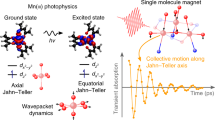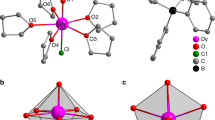The quantum tunneling of magnetization accelerates magnetic relaxation in transition and rare-earth ion complexes and often leads to the degradation of the characteristics of single-molecule or single-ion magnets. On the other hand, the applied dc magnetic field slows down the quantum tunneling of magnetization and favors other channels of spin relaxation. In this work, the stray magnetic field related to ferromagnetic microparticles occurring in the SIM composite with PrDyFeCoB microparticles is proposed instead of the applied field. The adjustable remanent magnetization of microparticles makes it possible to control the required stray field, which can be used to tune the spin relaxation rate in the complexes surrounding the microparticles. In this case, a slow spin relaxation is observed at zero applied field.





Similar content being viewed by others
REFERENCES
R. Mitsuhashi, K. S. Pedersen, T. Ueda, T. Suzuki, J. Bendix, and M. Mikuriya, Chem. Commun. 54, 8869 (2018). https://doi.org/10.1039/C8CC04756A
M. Mannini, F. Pineider, P. Sainctavit, C. Danieli, E. Otero, C. Sciancalepore, A. M. Talarico, M. Arrio, A. Cornia, D. Gatteschi, and R. Sessoli, Nat. Mater. 8, 194 (2009). https://doi.org/10.1038/nmat2374
M. Leuenberger and D. Loss, Nature (London, U.K.) 410, 789 (2001). https://doi.org/10.1038/35071024
R. Sessoli, D. Gatteschi, A. Caneschi, and M. A. Novak, Nature (London, U.K.) 365, 141 (1993). https://doi.org/10.1038/365141a0
Y. S. Meng, S. D. Jiang, B. W. Wang, and S. Gao, Acc. Chem. Res. 49, 2381 (2016). https://doi.org/10.1021/acs.accounts.6b00222
G. A. Craig and M. Murrie, Chem. Soc. Rev. 44, 2135 (2015). https://doi.org/10.1039/C4CS00439F
Y. P. Tupolova, I. N. Shcherbakov, L. D. Popov, V. E. Lebedev, V. V. Tkachev, K. V. Zakharov, A. N. Vasiliev, D. V. Korchagin, A. V. Palii, and S. M. Aldoshin, Dalton Trans. 48, 6960 (2019). https://doi.org/10.1039/C9DT00770A
E. N. Kablov, O. G. Ospennikova, V. P. Piskorskii, E. I. Kunitsyna, A. D. Talantsev, and R. B. Morgunov, IEEE Trans. Magn. 52, 2102012 (2016). https://doi.org/10.1134/S1063783416060184
P. Mendoza Zélis, V. Vega, V. M. Prida, L. C. Costa-Arzuza, F. Beron, K. R. Pirota, R. López-Ruiz, and F. H. Sánchez, Phys. Rev. B 96, 174427 (2017). https://doi.org/10.1103/PhysRevB.96.174427
F. H. Sánchez, P. Mendoza Zelis, M. L. Arciniegas, G. A. Pasquevich, and M. B. Fernández van Raap, Phys. Rev. B 95, 134421 (2017). https://doi.org/10.1103/PhysRevB.95.134421
B. A. Aronzon, D. Yu. Kovalev, A. N. Lagar’kov, E. Z. Meilikhov, V. V. Ryl’kov, M. V. Sedova, N. Negre, M. Goiran, and J. Leotin, JETP Lett. 70, 90 (1999).
Yu. O. Mikhailovsky, D. E. Mettus, A. P. Kazakov, V. N. Prudnikov, Yu. E. Kalinin, A. S. Sitnikov, A. Gerber, D. Bartov, and A. B. Granovsky, JETP Lett. 97, 473 (2013).
B. A. Aronzon, A. B. Granovski, D. Yu. Kovalev, E. Z. Meilikhov, V. V. Ryl’kov, and M. A. Sedova, JETP Lett. 71, 469 (2000).
M. A. Kozhushner and L. I. Trakhtenberg, J. Exp. T-heor. Phys. 111, 1010 (2010).
A. S. Borukhovich, N. I. Ignat’eva, A. I. Galyas, S. S. Dorofeichik, and K. I. Yanushkevich, JETP Lett. 84, 502 (2006).
K. E. Nikiruy, A. V. Emelyanov, V. V. Rylkov, A. V. Sitnikov, and V. A. Demin, Tech. Phys. Lett. 45, 386 (2019).
V. V. Rylkov, A. V. Emelyanov, S. N. Nikolaev, K. E. Nikiruy, A. V. Sitnikov, E. A. Fadeev, V. A. Demin, and A. B. Granovsky, J. Exp. Theor. Phys. 131, 160 (2020).
ACKNOWLEDGMENTS
We are grateful to S.M. Aldoshin and D.V. Korchagin for fruitful discussions and to I.N. Shcherbakov and Yu.P. Tupolova for placing the sample of Co complex at our disposal.
Funding
This work was supported by the Russian Foundation for Basic Research (project no. 20-33-90256) and the Council of the President of the Russian Federation for State Support of Young Scientists and Leading Scientific Schools (project no. NSh-2644.2020.2) and was performed within the framework of the thematical roadmap no. АААА-А19-119092390079-8 of the Institute of Problems of Chemical Physics, Russian Academy of Sciences.
Author information
Authors and Affiliations
Corresponding author
Additional information
Translated by K. Kugel
Rights and permissions
About this article
Cite this article
Koplak, O.V., Dvoretskaya, E.V., Kunitsyna, E.I. et al. Spin Relaxation in Single-Ion Magnets under the Slowing Down Effect Produced by the Stray Field of Ferromagnetic Microparticles. Jetp Lett. 113, 794–800 (2021). https://doi.org/10.1134/S0021364021120080
Received:
Revised:
Accepted:
Published:
Issue Date:
DOI: https://doi.org/10.1134/S0021364021120080




